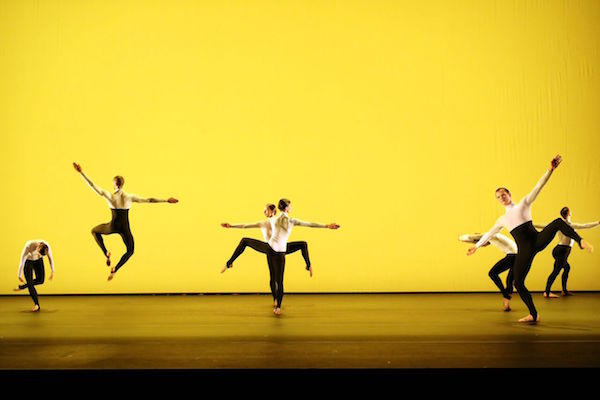Michael Clark Company: to a simple rock ‘n’ roll… song
Drama Theatre, Sydney Opera House, January 31
Judging by the enthusiastic audience response to Michael Clark Company’s performance of to a simple rock ‘n’ roll…. song, this production is an outstanding success. Described in the written programme as a musical homage to three composers who have inspired director/choreographer Michael Clark, the program is divided musically into three acts (one for each composer). Yet the second and third acts are much more vibrant and powerful than the first. Perhaps the explanation for this is that the first act is not simply a musical homage but also a choreographic one in which Michael Clark references works by Frederick Ashton, Merce Cunningham and Yvonne Rainer that were also choreographed to music by Erik Satie.
The understated neoclassicism of Ashton’s Monotones I and II, juxtaposed with the clean, early-modern lines characteristic of Cunningham technique, don’t fuse with Clark’s own idiosyncratic movement language; but they do provide a contextual counterpoint from which you can appreciate the second and third acts that much more. This is a clever way of taking the audience on a chronological journey, both musically and choreographically, which is satisfying and meaningful on both levels.

The second act is set to music by Patti Smith, and Michael Clark’s movement captures the kind of establishment-defying cool that was characteristic of Patti Smith’s music in her heyday. At this point in the program the Michael Clark Company’s eight dancers really came to life. It’s as if the first act was just a rehearsal, or warm-up, for what was to follow. They danced with style, conviction and verve, characterised by a rubbery, loose quality that allowed them to move seamlessly from classical technique to movements derived from popular dance. As they were listed only as a group, I cannot single out any one dancer for particular mention, but they were all very good.
Costuming and set design for this production is minimal, but effective. The dancers wear figure-hugging unitards (a different style for each act) attributed to Stevie Stewart and Michael Clark, while the many coloured hues of Charles Atlas’s lighting design play an integral part in setting the scene for each act. With the exception of "Painting by Numbers", a stage adaptation of a video installation by Charles Atlas that forms the backdrop to the second act, visual focus centres purely on the dancers.
In the third and final act, music by the late David Bowie gave Michael Clark full licence to put the quirky eccentricity of Bowie’s music into movement – and this was where the Michael Clark Company really came into its own. Watching this act, I saw the rhythm and melody of Bowie’s music played out onstage in more detail than I could ever have heard it simply by listening. “See the music, hear the dance,” is a quote attributed to George Balanchine that is most frequently discussed in conjunction with his own ballets; but in the second and third acts of to a simple rock ‘n’ roll… song Michael Clark achieves it too.
- GERALDINE HIGGINSON
Top: Act II sees the dancers really come to life. Pictured is Daniel Corthorn. Photo: Prudence Upton.



